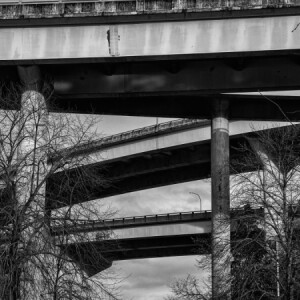Landscape of Inequality
After a long Zoom, yesterday two hours and today three, presented by CRUX, I went for a walk, thinking about topics covered by the five photographers: exploitation of Black workers, young women athletes surviving sexual assault, incarceration of immigrants, exploitation of trees and animals, and income inequality. As I walked on this gray, wet day, I reflected that I live in a landscape of inequality, and I suppose most of us do. First I came to a tent village under a freeway; then I viewed the freeway itself as a monument to fossil fuels and cars (extra). On the way home, I saw workers on a scaffolding seven stories high, building apartments they cannot afford to rent.
On the zoom with me were four other Blippers, including WalkingMarj, who told us about this opportunity and blipped us enjoying it.
I enjoyed all five presentations. What inspired me most was Raymond Thompson, Jr.’s project, Appalachian Ghost. He found a book of poetry by Muriel Rukeyser called The Book of the Dead, with photographs by Nancy Naumburg and a long essay by Catherine Venable Moore. The book, written in 1938 and republished in 2018, tells of a mine in West Virginia where nearly eight hundred Black men died working in tunnels because Union Carbide made no effort to protect them from the known danger to their lungs and bodies of silica dust. Most died from silicosis, and the company kept no records of their names.
Thompson, a Black former photojournalist from that region of the USA, was moved by the poems and photographs and wanted to go beyond photojournalism to experience the landscape, photograph it as it is now, and incorporate information in the project. He made photographs of Black workers in what looks like silica dust (he used talcum powder, if I understood him correctly). There are samples of that project on his website that I linked above. Then he became interested in stories of enslaved people who escaped slavery and made lives in the swamps near the place where he was born. He photographed trees and thought about lynching, swamps; thought about how people could carve out lives in those swamps and remain hidden from slave patrols. He explored the intersections of landscape, history, and photography.
I could go on and on about the other four photographers, but this page from the CRUX website includes links to all of them and their work. Greg Constantine’s photographs of immigrants in detention formed the backdrop for an Immigration Mass (only 27 minutes, but I haven’t had time to listen to it yet; I’m leaving it here so I can come back to it).


Comments
Sign in or get an account to comment.


